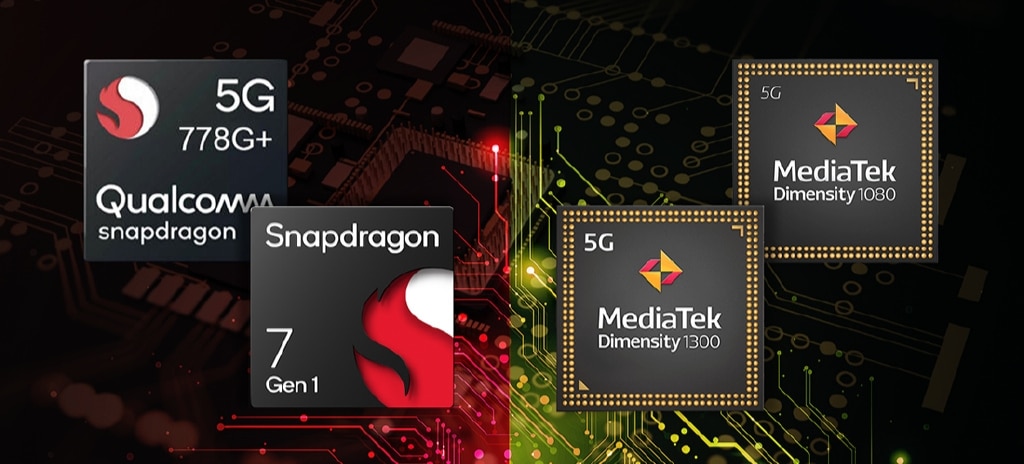Advertisements

The performance comparison of mobile phone chipsets is always a topic that users talk about, but most people will always focus on the flagship chipsets with the highest performance. In the past year, there have been more discussions such as Snapdragon 8+, Dimensity 9000. No matter how bad it is, it must be the sub-flagship such as Dimensity 8100 and Snapdragon 870.
It’s just that outside the field of vision of users, there are still a large number of mid-range models equipped with relatively poor performance Snapdragon 7 series or Dimensity 1000 series chips, and the market shipments of many models are quite impressive. Today we will pick out four typical mid-range chipsets currently on the market – Snapdragon 778G+, Snapdragon 7 Gen 1, Dimensity 1300 and Dimensity 1080, and use the game to see the performance of these mid-range chips. What is the actual performance level.
Gaming Test
The participating models include iQOO Z6 with Snapdragon 778G+, Xiaomi Civi 2 with Snapdragon 7 Gen 1, OPPO Reno 8 with Dimensity 1300, and Redmi Note 12 Pro with Dimensity 1080.
Under the low load of 60 frames, the average power consumption of the game is less than 3W, and the body temperature is controlled below 39°C. Among them, the average power consumption of the Redmi Note 12 Pro equipped with Dimensity 1080 is controlled at 2365.53mW, showing excellent performance. Low-load energy efficiency. The best power consumption control in 90 frame mode is OPPO Reno 8 equipped with Dimensity 1300, with an average power consumption of only 2814.7mW. The average power consumption of Xiaomi Civi 2, Reno 8, and Redmi Note 12 Pro are all Less than 3W.
Some sharp-eyed people may have discovered this. The average power consumption of iQOO Z6 games is always higher than that of the other three models. Is it because of the 778G+? What about the low-power? If you switch to the OLED, which is also Snapdragon 778G+, the power consumption of the two games is actually lower, so we speculate that it may be related to the higher power consumption of the LCD.
The 3.0GHz high-frequency A78 large core and the scale advantage of the Mali G77 MC9 GPU, Dimensity 1300’s Reno 8 ran an average of 48.38fps, far away from other opponents. Of course, the price is With higher power consumption and body temperature, it is unavoidable to obviously feel the heat of the body during the game.
The average frame rate of the models equipped with the other three chips is all below 40fps, and the highest frame rate is less than 60. It is basically impossible to play smoothly-even if the rendering resolution of some models is as low as 560P.
If you have to distinguish among them, iQOO Z6 with Snapdragon 778+ is slightly better than Redmi Note 12 Pro with Dimensity 1080, and Xiaomi Civi 2 with Snapdragon 7 Gen 1 is at the bottom.
Mid-range chipset is becoming more and more tasteless?
After testing, it can be found that Dimensity 1300 is the SoC with the best comprehensive game performance. It can run smoothly at full frames with low power consumption, and the frame rate is also the highest. . After all, in terms of architecture, it is actually an evolution of MediaTek’s previous flagship Dimensity 1200. The size of the three 2.6GHz A78 mid-cores has crushed several other large cores; but this performance is only relatively speaking. Yes, the performance gap from the flagship Snapdragon 8+ and Dimensity 9000+ platforms is still very large.
Compared with the Snapdragon 778G+, Qualcomm’s new Snapdragon 7 Gen 1 performance this year has no improvement or even reversed. The performance of the two is generally similar to that of the MediaTek Dimensity 1080. No pressure for low- and medium-load games. When it comes to heavy games, there is nothing you can do.
Of course, we can also see from the test that the advantages of these mid-range chipsets lie in power consumption control. It appeared. But whether it is a manufacturer or a user, the pursuit of more extreme performance is definitely still the high-end, so we can observe in the past one or two years that more and more manufacturers are using flagship performance devices like the Snapdragon 870 and Dimensity 8100.
The chip is distributed to the mid-range. Under the temptation to buy Dimensity 8100 / Snapdragon 870 models for less than 280 dollars, the market for mid-range chips that originally belonged to the Snapdragon 6 series and 7 series has been greatly squeezed. Look, it may be a big trend for this kind of mid-range chipsets with small core size and weak performance to become tasteless, or even be squeezed out of the market. Because of this, Qualcomm’s sincerity in the Snapdragon 7 Gen 1 chipset this year is so obvious.






